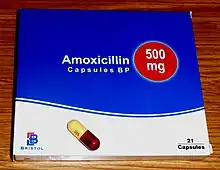Amoxicillin
 | |
 | |
| Names | |
|---|---|
| Pronunciation | /əˌmɒksɪˈsɪlɪn/ |
| Trade names | Hundreds of names[1] |
| Other names | Amoxycillin, amox, amoxycillin (AAN AU) |
IUPAC name
| |
| Clinical data | |
| Drug class | β-lactam antibiotic |
| Main uses | Middle ear infection, strep throat, pneumonia, skin infections, urinary tract infections[2] |
| Side effects | Nausea, rash[2] |
| WHO AWaRe | UnlinkedWikibase error: ⧼unlinkedwikibase-error-statements-entity-not-set⧽ |
| Pregnancy category |
|
| Routes of use | By mouth, intravenous |
| Defined daily dose | 1.5 (by mouth) or 3 g (parenteral)[3] |
| External links | |
| AHFS/Drugs.com | Monograph |
| MedlinePlus | a685001 |
| Legal | |
| License data |
|
| Legal status | |
| Pharmacokinetics | |
| Bioavailability | 95% by mouth |
| Metabolism | less than 30% biotransformed in liver |
| Elimination half-life | 61.3 minutes |
| Excretion | Kidneys |
| Chemical and physical data | |
| Formula | C16H19N3O5S |
| Molar mass | 365.40 g·mol−1 |
| 3D model (JSmol) | |
| Density | 1.6±0.1 [4] g/cm3 |
SMILES
| |
InChI
| |
Amoxicillin is an antibiotic used to treat a number of bacterial infections.[2] These include middle ear infection, strep throat, pneumonia, skin infections, and urinary tract infections among others.[2] It is taken by mouth, or less commonly by injection.[2][5]
Common adverse effects include nausea and rash.[2] It may also increase the risk of yeast infections and, when used in combination with clavulanic acid, diarrhea.[6] It should not be used in those who are allergic to penicillin.[2] While usable in those with kidney problems, the dose may need to be decreased.[2] Its use in pregnancy and breastfeeding does not appear to be harmful.[2] Amoxicillin is in the beta-lactam family of antibiotics.[2]
Amoxicillin was discovered in 1958 and came into medical use in 1972.[7][8] It is on the World Health Organization's List of Essential Medicines.[9] It is one of the most commonly prescribed antibiotics in children.[10] Amoxicillin is available as a generic medication and is relatively inexpensive.[2][11] In 2017, it was the 18th most commonly prescribed medication in the United States, with more than 27 million prescriptions.[12][13]
Medical uses

Amoxicillin is used in the treatment of a number of infections, including acute otitis media, streptococcal pharyngitis, pneumonia, skin infections, urinary tract infections, Salmonella infections, Lyme disease, and chlamydia infections.[2][14] It is in the 'access' group of the WHO AWaRe Classification.[15]
Acute otitis media
Children with acute otitis media who are younger than 6 months of age are generally treated with amoxicillin or other antibiotics. Although most children with acute otitis media who are older than two years old do not benefit from treatment with amoxicillin or other antibiotics, such treatment may be helpful in children younger than two years old with acute otitis media that is bilateral or accompanied by ear drainage.[16] In the past, amoxicillin was dosed three times daily when used to treat acute otitis media, which resulted in missed doses in routine ambulatory practice. There is now evidence that two times daily dosing or once daily dosing has similar effectiveness.[17]
Respiratory infections
Amoxicillin and amoxicillin-clavulanate have been recommended by guidelines as the drug of choice for bacterial sinusitis and other respiratory infections.[14] Most sinusitis infections are caused by viruses, for which amoxicillin and amoxicillin-clavulanate are ineffective,[18] and the small benefit gained by amoxicillin may be overridden by the adverse effects.[19] Amoxicillin is recommended as the preferred first-line treatment for community-acquired pneumonia in adults by the National Institute for Health and Care Excellence, either alone (mild to moderate severity disease) or in combination with a macrolide.[20] The World Health Organization (WHO) recommends amoxicillin as first-line treatment for pneumonia that is not "severe".[21] Amoxicillin is used in post-exposure inhalation of anthrax to prevent disease progression and for prophylaxis.[14]
Amoxicillin is recommended by the World Health Organization for the treatment of infants with signs and symptoms of pneumonia in resource-limited situations when the parents are unable or unwilling to accept hospitalization of the child. Amoxicillin in combination with gentamicin is recommended for the treatment of infants with signs of other severe infections when hospitalization is not an option.[22]
H. pylori
It is effective as one part of a multi-drug regimen for treatment of stomach infections of Helicobacter pylori. It is typically combined with a proton-pump inhibitor (such as omeprazole) and a macrolide antibiotic (such as clarithromycin); other drug combinations are also effective.[23]
Lyme borreliosis
Amoxicillin is effective for treatment of early cutaneous Lyme borreliosis; the effectiveness and safety of oral amoxicillin is neither better nor worse than common alternatively-used antibiotics.[24]
Skin infections
Amoxicillin is occasionally used for the treatment of skin infections,[14] such as acne vulgaris.[25] It is often an effective treatment for cases of acne vulgaris that have responded poorly to other antibiotics, such as doxycycline and minocycline.[26]
Prevention of endocarditis
It is also used to prevent bacterial endocarditis in high-risk people having dental work done, to prevent Streptococcus pneumoniae and other encapsulated bacterial infections in those without spleens, such as people with sickle-cell disease, and for both the prevention and the treatment of anthrax.[2] The United Kingdom recommends against its use for infectious endocarditis prophylaxis.[27] These recommendations do not appear to have changed the rates of infection for infectious endocarditis.[28]
Combination treatment
Amoxicillin is susceptible to degradation by β-lactamase-producing bacteria, which are resistant to most β-lactam antibiotics, such as penicillin. For this reason, it may be combined with clavulanic acid, a β-lactamase inhibitor. This drug combination is commonly called co-amoxiclav.[29]
Spectrum of activity
It is a moderate-spectrum, bacteriolytic, β-lactam antibiotic in the aminopenicillin family used to treat susceptible Gram-positive and Gram-negative bacteria. It is usually the drug of choice within the class because it is better-absorbed, following oral administration, than other β-lactam antibiotics. In general, Streptococcus, Bacillus subtilis, Enterococcus, Haemophilus, Helicobacter, and Moraxella are susceptible to amoxicillin, whereas Citrobacter, Klebsiella and Pseudomonas aeruginosa are resistant to it.[30] Some E. coli and most clinical strains of Staphylococcus aureus have developed resistance to amoxicillin to varying degrees.
Dosage
The defined daily dose is 1.5 g (by mouth) or 3 g (parenteral).[3] In adults it is often given as 500 to 875 mg twice by mouth per day.[31] Though doses of 500 to 1,000 mg three times per day may be used.[31]
In children doses of 12.5 to 45 mg/kg twice a day may be used.[31] Or doses of 30 mg/kg three times a day for more severe infections may be used.[2]
The duration of treatment is 5 days for otitis media, 6 days for tonsillitis, and 7 to 10 days for pneumonia and sinusitis.[32]
Side effects
Side effects are similar to those for other β-lactam antibiotics, including nausea, vomiting, rashes, and antibiotic-associated colitis. Loose bowel movements (diarrhea) may also occur. Rarer adverse effects include mental changes, lightheadedness, insomnia, confusion, anxiety, sensitivity to lights and sounds, and unclear thinking. Immediate medical care is required upon the first signs of these adverse effects.
The onset of an allergic reaction to amoxicillin can be very sudden and intense; emergency medical attention must be sought as quickly as possible. The initial phase of such a reaction often starts with a change in mental state, skin rash with intense itching (often beginning in fingertips and around groin area and rapidly spreading), and sensations of fever, nausea, and vomiting. Any other symptoms that seem even remotely suspicious must be taken very seriously. However, more mild allergy symptoms, such as a rash, can occur at any time during treatment, even up to a week after treatment has ceased. For some people allergic to amoxicillin, the adverse effects can be fatal due to anaphylaxis.
Use of the amoxicillin/clavulanic acid combination for more than one week has caused mild hepatitis in some patients. Young children having ingested acute overdoses of amoxicillin manifested lethargy, vomiting, and renal dysfunction.[33][34]
There is poor reporting of adverse effects of amoxicillin from clinical trials. For this reason, the severity and frequency of adverse effects from amoxicillin is probably higher than reported from clinical trials.[35]
Nonallergic rash
Between 3 and 10% of children taking amoxicillin (or ampicillin) show a late-developing (>72 hours after beginning medication and having never taken penicillin-like medication previously) rash, which is sometimes referred to as the "amoxicillin rash". The rash can also occur in adults.
The rash is described as maculopapular or morbilliform (measles-like; therefore, in medical literature, it is called "amoxicillin-induced morbilliform rash".[36]). It starts on the trunk and can spread from there. This rash is unlikely to be a true allergic reaction and is not a contraindication for future amoxicillin usage, nor should the current regimen necessarily be stopped. However, this common amoxicillin rash and a dangerous allergic reaction cannot easily be distinguished by inexperienced persons, so a healthcare professional is often required to distinguish between the two.[37][38]
A nonallergic amoxicillin rash may also be an indicator of infectious mononucleosis. Some studies indicate about 80-90% of patients with acute Epstein Barr virus infection treated with amoxicillin or ampicillin develop such a rash.[39]
 Nonallergic amoxicillin rash eight days after first dose: This photo was taken 24 hours after the rash began.
Nonallergic amoxicillin rash eight days after first dose: This photo was taken 24 hours after the rash began. Eight hours after the first photo, individual spots have grown and begun to merge.
Eight hours after the first photo, individual spots have grown and begun to merge. At 23 hours after the first photo, the color appears to be fading, and much of rash has spread to confluence.
At 23 hours after the first photo, the color appears to be fading, and much of rash has spread to confluence.
Interactions
Amoxicillin may interact with these drugs:
- Anticoagulants (dabigatran, warfarin).[40][14]
- Cancer treatment (methotrexate).
- Uricosuric drugs.
- Typhoid vaccine[41]
- Probenecid reduces renal excretion and increases the blood levels of amoxicillin.
- Oral contraceptives may become less effective.
- Allopurinol (gout treatment).
Pharmacology
Amoxicillin (α-amino-p-hydroxybenzyl penicillin) is a semisynthetic derivative of penicillin with a structure similar to ampicillin but with better absorption when taken by mouth, thus yielding higher concentrations in blood and in urine.[42] Amoxicillin diffuses easily into tissues and body fluids. Penetration into the central nervous system increases in meningitis. It will cross the placenta and is excreted into breastmilk in small quantities. It is excreted into the urine and metabolized by the liver. It has an onset of 30 minutes and a half-life of 3.7 hours in newborns and 1.4 hours in adults.[14]
Amoxicillin attaches to the cell wall of susceptible bacteria and results in their death. It also is a bactericidal compound. It is effective against streptococci, pneumococci, enterococci, Haemophilus influenzae, Escherichia coli, Proteus mirabilis, Neisseria meningitidis, Neisseria gonorrhoeae, Shigella, Chlamydia trachomatis, Salmonella, Borrelia burgdorferi, and Helicobacter pylori.[14] As a derivative of ampicillin, amoxicillin is a member of the penicillin family and, like penicillins, is a β-lactam antibiotic.[43] It inhibits cross-linkage between the linear peptidoglycan polymer chains that make up a major component of the bacterial cell wall. It has two ionizable groups in the physiological range (the amino group in alpha-position to the amide carbonyl group and the carboxyl group).[44]
History
Amoxicillin was one of several semisynthetic derivatives of 6-aminopenicillanic acid (6-APA) developed at Beecham, England in the 1960s.[45][46] It became available in 1972 and was the second aminopenicillin to reach the market (after ampicillin in 1961).[47][48][49] Co-amoxiclav became available in 1981.[48]
Society and culture
Cost
Amoxicillin is relatively inexpensive.[11] It has a wholesale cost in the developing world of between US$0.02 and $0.05 per pill.[50] In the United States, ten days of treatment costs about US$16 ($0.40 per pill).[2] In 2017, it was the 18th most commonly prescribed medication in the United States, with more than 27 million prescriptions.[12][13]
.svg.png.webp) Amoxicillin costs (USA)
Amoxicillin costs (USA).svg.png.webp) Amoxicillin prescriptions (USA)
Amoxicillin prescriptions (USA)
Modes of delivery
Pharmaceutical manufacturers make amoxicillin in trihydrate form, for oral use available as capsules, regular, chewable and dispersible tablets, syrup and pediatric suspension for oral use, and as the sodium salt for intravenous administration. Amoxicillin is most commonly taken orally. The liquid forms are helpful where the patient might find it difficult to take tablets or capsules.
An extended-release is available.[51] The intravenous form of amoxicillin is not sold in the United States.[52] When an intravenous aminopenicillin is required in the United States, ampicillin is typically used. When there is an adequate response to ampicillin, the course of antibiotic therapy may often be completed with oral amoxicillin.[53]
Research with mice indicated successful delivery using intraperitoneally injected amoxicillin-bearing microparticles.[54]
Names
"Amoxicillin" is the International Nonproprietary Name (INN), British Approved Name (BAN), and United States Adopted Name (USAN), while "amoxycillin" is the Australian Approved Name (AAN).
Amoxicillin is one of the semisynthetic penicillins discovered by Beecham scientists. The patent for amoxicillin has expired, thus amoxicillin and co-amoxiclav preparations are marketed under various trade names across the world.[1]
Other animals
Amoxicillin is also sometimes used as an antibiotic for animals. The use of amoxicillin for animals intended for human consumption (chickens, cattle, and swine for example) has been approved.[55]
References
- 1 2 "International brand names for amoxicillin". www.drugs.com. Drugs.com. Archived from the original on 29 May 2016. Retrieved 15 November 2016.
- 1 2 3 4 5 6 7 8 9 10 11 12 13 14 15 "Amoxicillin". The American Society of Health-System Pharmacists. Archived from the original on 5 September 2015. Retrieved 1 August 2015.
- 1 2 "WHOCC - ATC/DDD Index". www.whocc.no. Archived from the original on 7 October 2020. Retrieved 22 September 2020.
- ↑ "Amoxicillin". www.chemsrc.com. Archived from the original on 2017-05-19. Retrieved 2018-05-08.
- ↑ "Amoxicillin Sodium for Injection". EMC. 10 February 2016. Archived from the original on 27 October 2016. Retrieved 26 October 2016.
- ↑ Gillies, M; Ranakusuma, A; Hoffmann, T; Thorning, S; McGuire, T; Glasziou, P; Del Mar, C (17 November 2014). "Common harms from amoxicillin: a systematic review and meta-analysis of randomized placebo-controlled trials for any indication". CMAJ : Canadian Medical Association Journal. 187 (1): E21–31. doi:10.1503/cmaj.140848. PMC 4284189. PMID 25404399.
- ↑ Fischer, Janos; Ganellin, C. Robin (2006). Analogue-based Drug Discovery. John Wiley & Sons. p. 490. ISBN 9783527607495. Archived from the original on 2017-09-08.
- ↑ Roy, Jiben (2012). An introduction to pharmaceutical sciences production, chemistry, techniques and technology. Cambridge: Woodhead Pub. p. 239. ISBN 9781908818041. Archived from the original on 2017-09-08.
- ↑ World Health Organization (2019). World Health Organization model list of essential medicines: 21st list 2019. Geneva: World Health Organization. hdl:10665/325771. WHO/MVP/EMP/IAU/2019.06. License: CC BY-NC-SA 3.0 IGO.
- ↑ Kelly, Deirdre (2008). Diseases of the liver and biliary system in children (3 ed.). Chichester, UK: Wiley-Blackwell. p. 217. ISBN 9781444300543. Archived from the original on 2017-09-08.
- 1 2 Hanno, Philip M.; Guzzo, Thomas J.; Malkowicz, S. Bruce; Wein, Alan J. (2014). Penn Clinical Manual of Urology E-Book. Elsevier Health Sciences. p. 122. ISBN 978-0-323-24466-4. Archived from the original on 2021-08-27. Retrieved 2020-03-30.
- 1 2 "The Top 300 of 2020". ClinCalc. Archived from the original on 18 March 2020. Retrieved 11 April 2020.
- 1 2 "Amoxicillin Drug Usage Statistics". ClinCalc. 1 December 1981. Archived from the original on 11 April 2020. Retrieved 11 April 2020.
- 1 2 3 4 5 6 7 "Amoxicillin" (PDF). Davis. 2017. Archived (PDF) from the original on September 8, 2017. Retrieved March 22, 2017.
- ↑ Zanichelli, Veronica; Sharland, Michael; Cappello, Bernadette; Moja, Lorenzo; Getahun, Haileyesus; Pessoa-Silva, Carmem; Sati, Hatim; van Weezenbeek, Catharina; Balkhy, Hanan; Simão, Mariângela; Gandra, Sumanth; Huttner, Benedikt (1 April 2023). "The WHO AWaRe (Access, Watch, Reserve) antibiotic book and prevention of antimicrobial resistance". Bulletin of the World Health Organization. 101 (4): 290–296. doi:10.2471/BLT.22.288614. ISSN 0042-9686. Archived from the original on 7 May 2023. Retrieved 17 November 2023.
- ↑ Venekamp, Roderick P.; Sanders, Sharon L.; Glasziou, Paul P.; Del Mar, Chris B.; Rovers, Maroeska M. (2015-06-23). "Antibiotics for acute otitis media in children" (PDF). The Cochrane Database of Systematic Reviews (6): CD000219. doi:10.1002/14651858.CD000219.pub4. ISSN 1469-493X. PMC 7043305. PMID 26099233. Archived (PDF) from the original on 2021-08-27. Retrieved 2019-09-24.
- ↑ Thanaviratananich S, Laopaiboon M, Vatanasapt P (December 2013). "Once or twice daily versus three times daily amoxicillin with or without clavulanate for the treatment of acute otitis media". Cochrane Database Syst Rev (12): CD004975. doi:10.1002/14651858.CD004975.pub3. PMID 24338106.
- ↑ American Academy of Allergy, Asthma, and Immunology. "Five Things Physicians and Patients Should Question" (PDF). Choosing Wisely: An Initiative of the ABIM Foundation. American Academy of Allergy, Asthma, and Immunology. Archived (PDF) from the original on November 3, 2012. Retrieved August 14, 2012.
{{cite journal}}: CS1 maint: uses authors parameter (link) - ↑ Ahovuo-Saloranta, A.; Rautakorpi, U. M.; Borisenko, O. V.; Liira, H.; Williams Jr, J. W.; Mäkelä, M. (2014). Ahovuo-Saloranta, Anneli (ed.). "Antibiotics for acute maxillary sinusitis". The Cochrane Library (2): CD000243. doi:10.1002/14651858.CD000243.pub3. PMID 24515610.
- ↑ Pneumonia - National Library of Medicine - PubMed Health. National Institute for Health and Care Excellence: Clinical Guidelines. National Institute for Health and Care Excellence (UK). 2014. Archived from the original on 2017-09-08.
- ↑ Revised WHO Classification and Treatment of Pneumonia in Children at Health Facilities - NCBI Bookshelf. WHO Guidelines Approved by the Guidelines Review Committee. World Health Organization. 2014. ISBN 9789241507813. Archived from the original on 2017-09-08.
- ↑ Guideline: Managing Possible Serious Bacterial Infection in Young Infants When Referral Is Not Feasible - NCBI Bookshelf. WHO Guidelines Approved by the Guidelines Review Committee. World Health Organization. 2015. ISBN 9789241509268. Archived from the original on 2017-09-08.
- ↑ Chey WD, Leontiadis GI, Howden CW, Moss SF (February 2017). "ACG Clinical Guideline: Treatment of Helicobacter pylori Infection". Am. J. Gastroenterol. 112 (2): 212–239. doi:10.1038/ajg.2016.563. PMID 28071659.
- ↑ Torbahn G, Hofmann H, Rücker G, Bischoff K, Freitag MH, Dersch R, Fingerle V, Motschall E, Meerpohl JJ, Schmucker C (November 2018). "Efficacy and Safety of Antibiotic Therapy in Early Cutaneous Lyme Borreliosis: A Network Meta-analysis". JAMA Dermatol. 154 (11): 1292–1303. doi:10.1001/jamadermatol.2018.3186. PMC 6248135. PMID 30285069.
- ↑ "Adolescent Acne: Management". Archived from the original on 2010-12-22.
- ↑ "Amoxicillin and Acne Vulgaris". scienceofacne.com. 2012-09-05. Archived from the original on 2012-07-21. Retrieved 2012-08-17.
- ↑ "CG64 Prophylaxis against infective endocarditis: Full guidance" (PDF). NICE. Archived from the original (PDF) on 12 November 2011. Retrieved 8 June 2011.
- ↑ Thornhill, MH; Dayer, MJ; Forde, JM; Corey, GR; Chu, VH; Couper, DJ; Lockhart, PB (2011-05-03). "Impact of the NICE guideline recommending cessation of antibiotic prophylaxis for prevention of infective endocarditis: before and after study". BMJ (Clinical Research Ed.). 342: d2392. doi:10.1136/bmj.d2392. PMC 3086390. PMID 21540258.
- ↑ "Amoxicillin Susceptibility and Resistance Data" (PDF). Archived from the original (PDF) on 13 July 2019. Retrieved 20 July 2013.
- ↑ "Amoxicillin spectrum of bacterial susceptibility and Resistance" (PDF). Archived from the original (PDF) on 22 December 2018. Retrieved 8 April 2012.
- 1 2 3 "Amoxicillin - WikEM". www.wikem.org. Archived from the original on 1 October 2020. Retrieved 5 August 2020.
- ↑ "AMOXICILLIN oral - Essential drugs". medicalguidelines.msf.org. Archived from the original on 27 August 2021. Retrieved 25 August 2020.
- ↑ Cundiff j, Joe S.; Joe, S (2007). "Amoxicillin-clavulanic acid-induced hepatitis". Am. J. Otolaryngol. 28 (1): 28–30. doi:10.1016/j.amjoto.2006.06.007. PMID 17162128.
- ↑ R. Baselt (2008). Disposition of Toxic Drugs and Chemicals in Man (8th ed.). Foster City, CA: Biomedical Publications. pp. 81–83.
- ↑ Gillies M, Ranakusuma A, Hoffmann T, Thorning S, McGuire T, Glasziou P, Del Mar C (January 2015). "Common harms from amoxicillin: a systematic review and meta-analysis of randomized placebo-controlled trials for any indication". CMAJ. 187 (1): E21–31. doi:10.1503/cmaj.140848. PMC 4284189. PMID 25404399.
- ↑ "Role of delayed cellular hypersensitivity and adhesion molecules in amoxicillin-induced morbilliform rashes". Cat.inist.fr. Archived from the original on 2011-12-29. Retrieved 2010-11-13.
- ↑ Pichichero ME (April 2005). "A review of evidence supporting the American Academy of Pediatrics recommendation for prescribing cephalosporin antibiotics for penicillin-allergic patients". Pediatrics. 115 (4): 1048–57. doi:10.1542/peds.2004-1276. PMID 15805383. Archived from the original on 2008-12-18.
- ↑ Schmitt, Barton D. (2005). Your child's health: the parents' one-stop reference guide to symptoms, emergencies, common illnesses, behavior problems, healthy development (2nd ed.). New York: Bantam Books. ISBN 978-0-553-38369-0.
- ↑ Kagan, B (1977). "Ampicillin rash". Western Journal of Medicine. 126 (4): 333–335. PMC 1237570. PMID 855325.
- ↑ British National Formulary 57 March 2009
- ↑ Arcangelo, Virginia Poole; Peterson, Andrew M.; Wilbur, Veronica; Reinhold, Jennifer A. (August 17, 2016). Pharmacotherapeutics for Advanced Practice: A Practical Approach. LWW. ISBN 978-1-496-31996-8. Archived from the original on July 25, 2020. Retrieved August 14, 2017.
- ↑ Handsfield HH, Clark H, Wallace JF, Holmes KK, Turck M (February 1973). "Amoxicillin, a new penicillin antibiotic". Antimicrob. Agents Chemother. 3 (2): 262–5. doi:10.1128/AAC.3.2.262. PMC 444397. PMID 4208282.
- ↑ Alcamo, I. Edward (2003), Microbes and Society: An Introduction to Microbiology, Jones & Bartlett Learning, p. 198, ISBN 9780763714307, archived from the original on 2016-12-23, retrieved 2016-03-21.
- ↑ Sezer, Ali Demir, ed. (2016). Application of Nanotechnology in Drug Delivery. INTECH. p. 423. ISBN 9789535116288. Archived from the original on 2020-07-25. Retrieved 2019-07-24.
- ↑ GB patent 978178, John Herbert Charles Nayler & Harry Smith, "Penicillins", published 1964-12-16, assigned to Beecham Research Laboratories Ltd
- ↑ GB patent 1241844, Anthony Alfred Walter Long & John Herber Charles Nayler, "Penicillins", published 1971-08-04, assigned to Beecham Group LTD
- ↑ Geddes, AM; et al. (Dec 2007). "Introduction: historical perspective and development of amoxicillin/clavulanate". Int J Antimicrob Agents. 30 (Suppl 2): S109–12. doi:10.1016/j.ijantimicag.2007.07.015. PMID 17900874.
- 1 2 Raviña, E (2014). The Evolution of Drug Discovery. Weinheim: Wiley-VCH. p. 262. ISBN 9783527326693.
- ↑ Bruggink, A (2001). Synthesis of β-lactam antibiotics. Springer. p. 17. ISBN 978-0-7923-7060-4.
- ↑ "Amoxicillin". International Drug Price Indicator Guide. Archived from the original on 25 August 2018. Retrieved 1 August 2015.
- ↑ "Drug Approval Package: Moxatag (amoxicillin extended-release) NDA #050813". Archived from the original on 2019-12-03. Retrieved 2018-12-25.
- ↑ Marek, Cindy L.; Timmons, Sherry R. (2018). Nowak, Arthur (ed.). Antimicrobials in Pediatric Dentistry. Saunders. ISBN 978-0323608268. Archived from the original on 2019-07-25. Retrieved 2019-07-24.
- ↑ "Archive copy" (PDF). Archived (PDF) from the original on 2018-04-25. Retrieved 2018-11-21.
{{cite web}}: CS1 maint: archived copy as title (link) - ↑ Farazuddin, Mohammad; Chauhan, Arun; Khan, Raza M.M.; Owais, Mohammad (2011). "Amoxicillin-bearing microparticles: potential in the treatment of Listeria monocytogenes infection in Swiss albino mice". Bioscience Reports. 31 (4): 265–72. doi:10.1042/BSR20100027. PMID 20687896. S2CID 24810903.
- ↑ Ramos, Fernando; Boison, Joe; Friedlander, Lynn G. "Amoxicillin" (PDF). fao.org. Food and Agriculture Organization of the United Nations. Archived (PDF) from the original on 12 July 2018. Retrieved 8 November 2019.
External links
- "Amoxicillin". Drug Information Portal. U.S. National Library of Medicine. Archived from the original on 2020-07-26. Retrieved 2020-05-18.
| Identifiers: |
|---|